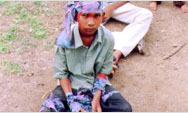Since the early 1990’s, Nepal’s community forestry program to pass on forest management and use rights to local groups has expanded dramatically. In 2000, a 46-hectare forest in Mid-Western Nepal was transferred to the Chauridanda community forestry user group (CFUG) to improve local management, protection, and use.
This CFUG consists of almost 1,000 people from various castes and ethnic groups including fifty Dalit households, also known as untouchables of which five are blacksmiths. These blacksmiths rely on charcoal to produce and repair agricultural tools. Initially, the Chauridanda CFUG management committee set a fee on charcoal production that the Dalit blacksmiths could not afford.
The Dalit blacksmiths stopped collecting wood from the community forest area and risked producing charcoal illegally in national forests instead. However, they still could not make enough charcoal to meet customer demand. Through local nongovernmental organizations, these blacksmiths learned about a training program sponsored by USAID that assists forest users to examine issues of equity and participation in resource management.
| 

